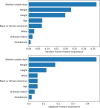Warfarin sensitivity is associated with increased hospital mortality in critically Ill patients
- PMID: 35511891
- PMCID: PMC9070894
- DOI: 10.1371/journal.pone.0267966
Warfarin sensitivity is associated with increased hospital mortality in critically Ill patients
Abstract
Background: Warfarin is a widely used anticoagulant with a narrow therapeutic index and large interpatient variability in the therapeutic dose. Warfarin sensitivity has been reported to be associated with increased incidence of international normalized ratio (INR) > 5. However, whether warfarin sensitivity is a risk factor for adverse outcomes in critically ill patients remains unknown. In the present study, we aimed to evaluate the utility of different machine learning algorithms for the prediction of warfarin sensitivity and to determine the impact of warfarin sensitivity on outcomes in critically ill patients.
Methods: Nine different machine learning algorithms for the prediction of warfarin sensitivity were tested in the International Warfarin Pharmacogenetic Consortium cohort and Easton cohort. Furthermore, a total of 7,647 critically ill patients was analyzed for warfarin sensitivity on in-hospital mortality by multivariable regression. Covariates that potentially confound the association were further adjusted using propensity score matching or inverse probability of treatment weighting.
Results: We found that logistic regression (AUC = 0.879, 95% CI: 0.834-0.924) was indistinguishable from support vector machine with a linear kernel, neural network, AdaBoost and light gradient boosting trees, and significantly outperformed all the other machine learning algorithms. Furthermore, we found that warfarin sensitivity predicted by the logistic regression model was significantly associated with worse in-hospital mortality in critically ill patients with an odds ratio (OR) of 1.33 (95% CI, 1.01-1.77).
Conclusions: Our data suggest that the logistic regression model is the best model for the prediction of warfarin sensitivity clinically and that warfarin sensitivity is likely to be a risk factor for adverse outcomes in critically ill patients.
Conflict of interest statement
The authors have declared that no competing interests exist.
Figures




Similar articles
-
Clinical Model for Predicting Warfarin Sensitivity.Sci Rep. 2019 Sep 6;9(1):12856. doi: 10.1038/s41598-019-49329-0. Sci Rep. 2019. PMID: 31492893 Free PMC article.
-
Pharmacogenetic-guided and clinical warfarin dosing algorithm assessments with bleeding outcomes risk-stratified by genetic and covariate subgroups.Int J Cardiol. 2020 Oct 15;317:159-166. doi: 10.1016/j.ijcard.2020.03.055. Epub 2020 Mar 21. Int J Cardiol. 2020. PMID: 32505370
-
Comparison of Nine Statistical Model Based Warfarin Pharmacogenetic Dosing Algorithms Using the Racially Diverse International Warfarin Pharmacogenetic Consortium Cohort Database.PLoS One. 2015 Aug 25;10(8):e0135784. doi: 10.1371/journal.pone.0135784. eCollection 2015. PLoS One. 2015. PMID: 26305568 Free PMC article.
-
Elevated International Normalized Ratio Is Associated With Ruptured Aneurysms.Stroke. 2018 Sep;49(9):2046-2052. doi: 10.1161/STROKEAHA.118.022412. Stroke. 2018. PMID: 30354989 Free PMC article.
-
Improvement of adequate use of warfarin for the elderly using decision tree-based approaches.Methods Inf Med. 2014;53(1):47-53. doi: 10.3414/ME13-01-0027. Epub 2013 Oct 18. Methods Inf Med. 2014. PMID: 24136011 Review.
Cited by
-
Study of target INR achievement, incidence of hemorrhagic complications and affecting factors after during warfarin treatment in western area of China.Sci Rep. 2025 May 25;15(1):18200. doi: 10.1038/s41598-025-03434-5. Sci Rep. 2025. PMID: 40415097 Free PMC article.
References
-
- D’Andrea G, D’Ambrosio RL, Di Perna P, Chetta M, Santacroce, Brancaccio V, et al.. A polymorphism in the VKORC1 gene is associated with an interindividual variability in the dose-anticoagulant effect of warfarin. Blood. 2005;105(2):645–9. Epub 2004/09/11. doi: 10.1182/blood-2004-06-2111 . - DOI - PubMed
MeSH terms
Substances
Supplementary concepts
LinkOut - more resources
Full Text Sources
Medical

